Tropical Albatros
DVa
Color Schemes of Jasta 300 (Palestine)
Text by Marlon Schultz - Illustration by Mark Miller

Albatros D.Va 5359/17
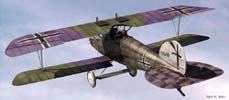
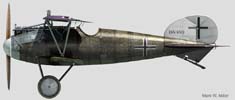
Heinz Nowarra identified this aircraft as belonging to Jasta 2(F)
(Jasta 300).
This Eiserne kreuz insignia that this tropical Albatros would probably have
been delivered with has been altered to the final style of National insignia
sanctioned by the German airforce. There is a possibility that the wings and
horizontal stabilizer of this aircraft are finished in the same way as the next
in line at the Albaros Werke - D.5360/17 - (see below). The cowl and struts
are in the factory pale grey-green finish while the fuselage appears in a dark
colour that appears to have been applied as a heavy stain. In keeping with the
belief of limited colour availability we have depicted this as black. I believe
black and white would be the colours most readily available because of their
need to repaint the national insignia after repairs. The propeller spinner,
wheel centres , fin and rudder are painted white. No remnant of the Albatros
factory decal survives on the rudder. The serial number of the aircraft is painted
in black, but curiously there is no year of production recorded . I find it
interesting that no remnants of the previous styles of the national insignia
which preceded those present when photographed do not show through on the fuselage
or fin.
A small portion of this aircraft's lower wing surface with the final style of
balken kreuz is visible and it appears the area surrounding the balken kreuz
is painted in a shade similar to the undersurface colour. Mark has therefore
depicted the top wing balkenkreuz with the painted out areas matching the surrounding
surfaces.
Albatros D.Va 5360/17
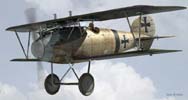
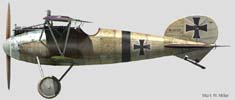
This aircraft was photographed in a damaged condition.and it's pilot has been
identified as Ltn. Victor Haeffner originally of Jasta 300.
The wings are camouflaged and have been depicted in the top pattern of mauve
to second rib on the left from the centre section cut-out \ dark green to the
first rib from the centre section cutout /mauve. Notice the unusual angles of
the demarcation line between mauve and green. Instead of the centre colour having
parallel ends they instead angle out from each other. The left lower wing panels
is dark green to the 5th rib from the root. Mauve to the root. The lower right
wing is not visible and Mark has positioned the demarcation line on this wing
in a possible location.It is suspected the right lower wing panel might possibly
be dark green to the third rib from the root / mauve to tip. (Note D)
The starboard side of the horizontal stabilizer and elevator is either covered
in clear doped linen replacement covering or the lozenge fabric pattern has
been washed out by the reflection from the sun. The lozenge pattern is visible
on the port side of the horizontal stabilizer and provides an interesting contrast
with the mauve and green painted wings. We have depicted the stabilizer as being
covered entirely with 5-colour lozenge with salmon pink rib tape.
The fuselage metal parts all struts and the spinner are most like in a pale
grey-green shade while for the most part the wooden part of the fuselage has
retained it factory clear varnished look. There is a dark coloured vertical
band encircling the fuselage, which we have depicted along with the serial number
as being black. As I
mentioned in the section dealing with 5359/17. I believe for the most part due
to supply problems, black and white paint would be the most accessible colours,
as they would be needed to re-paint the national insignia due to surface repairs.
There would be, as to any rule, exceptions.
Albatros D.Va 7416/17
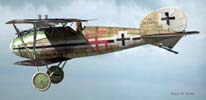
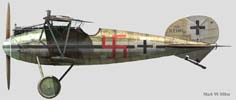
Heinz Nowarra identified this aircraft as belonging to Jasta 2(F) (Jasta 300).
We know now by the time this photograph was taken whatever Jasta number you
used was irrelevant as the Jasta had been reduced in strength to where it's
small numbers made it totally in-effect. This aircraft, Albatros D.Va 7416/17
was photographed along with D.5359/17 when the British captured them on the
airfield occupied by Fl. Abt. 304. They might have represented a major portion
of Jasta 1(F) operational capabilities.
This tropical Albatros D.Va came from the third production batch and probably
led quite an interesting existence. A number of times the Jasta was down to
one or two airplanes, the rest lost through attrition and combat. That an aircraft
carrying the national markings of March/April 1918 must have meant this aircraft
was around from nearly the beginning. It wore 5-colour lozenge on its wings
and horizontal stabilizer. Probably dark day on top /light day on the bottom
with salmon pink rib tapes. All metal parts, spinner, all struts, and wheel
centre's probably in typical Albatros light grey-green
The fuselage is depicted in natural wood with a centreline horizontal tri-stripe
believed to be white /black/white. Note how the tri-stripe wraps around the
spinner. The fuselage swastika appears lighter in the photographs than the centre
band of the centreline tri-stripe but is still a dark colour. It might be blue,
dark green, dark grey or as I have asked Mark to depict it as red. I have wondered
if the same pilot who applied centreline tri-stripe applied the swastika. If
not, then who applied the centre tri-line marking? Could it have been an attempt
at a jasta mark? Most likely not, since this Jasta was the only German fighter
unit in this theatre. How about another pilot's personal marking? But who marking
could it be The swastika has been associated with the Jasta 300 pilot Hermann
Kunz who is known to have used the swastika as a personal mark during his stay
with Jasta 7. Hauptman Franz Walz has also been identified as the pilot of this
aircraft. I have often wondered if an officer, who wasn't successful as a Jasta
leader in France, would be more concerned as commander that his units were well
supplied in this logistical nightmare than his participation in combat. I would
think someone more aggressive in the air such as the squadron leader Flecken
flying a conspicuous marked aircraft or as I mentioned above Kunz.
There is a small painted number "5 " on the fuselage tri- stripe
which has been depicted in the same colour as the swastika. Why the small number
"5"? . Did this Jasta once number it's aircraft with individual numbers
and this is the last survivor of that group? The serial number is unusual because
of the abbreviation "Alb." for Albatros above the number 7416/17.
The rudder is clear doped with the Albatros factory decal present.






